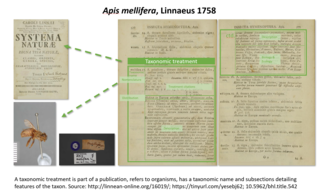
The Hydroscaphidae are a small family of water beetles known commonly as skiff beetles. As of 2010, there are 23 species in the family. Several are recently described.
Yara is a genus of beetles in the family Hydroscaphidae, from South America and Central America. Containing five species:

The acrobatic cavy also known as the acrobatic moco and climbing cavy is a cavy species native to Brazil. It is found from Goiás state to Tocantins state, west of the Espigão Mestre, Serra Geral de Goiás, and is also found in Terra Ronca State Park.

The Nyiro shrew is a species of mammal in the family Soricidae. It is endemic to Mount Nyiro in northern Kenya. This is a small shrew with dark brown dorsal pelage and grayish brown or slate gray ventral pelage.

Molytinae is a subfamily of weevils described by Carl Johan Schönherr in 1823.
Plazi is a Swiss-based international non-profit association supporting and promoting the development of persistent and openly accessible digital bio-taxonomic literature. Plazi is cofounder of the Biodiversity Literature Repository and is maintaining this digital taxonomic literature repository at Zenodo to provide access to FAIR data converted from taxonomic publications using the TreatmentBank service, enhances submitted taxonomic treatments by creating a version in the XML format Taxpub, and educates about the importance of maintaining open access to scientific discourse and data. It is a contributor to the evolving e-taxonomy in the field of Biodiversity Informatics.
Conasprella boucheti is a species of sea snail, a marine gastropod mollusk in the family Conidae, the cone snails and their allies.
Mordellistena hirayamai is a beetle in the genus Mordellistena of the family Mordellidae. It was described in 1933 by Kônô.

Trigonopterus baliensis is a species of flightless weevil in the genus Trigonopterus from Indonesia.
Maratus felinus is a species of peacock spider native to Australia. It was discovered at Lake Jasper and Mount Romance along with two other species, Maratus aquilus and Maratus combustus.
The Horáček's horseshoe bat is a species of bat in the family Rhinolophidae, which is endemic to Cyrenaica, Libya.

A taxonomic treatment is a section in a scientific publication documenting the features of a related group of organisms or taxa. Treatments have been the building blocks of how data about taxa are provided, ever since the beginning of modern taxonomy by Linnaeus 1753 for plants and 1758 for animals. Each scientifically described taxon has at least one taxonomic treatment. In today’s publishing, a taxonomic treatment tag

Nepenthes candalaga is a tropical pitcher plant endemic to Mt. Candalaga, in the Municipality of Maragusan, Davao de Oro, island of Mindanao, Philippines. This bringing the total number of Nepenthes species in this island to 38, making Mindanao the island with the highest concentration of Nepenthes species in the Philippines. Nepenthes candalaga is closely allied to N. justinae but differs in having a lamina with 2 – 3 longitudinal veins that are parallel with the midrib. Additionally, the orbicular lid of the pitchers, the lid spur tip that is non-bifid, the triangular lid appendage, the short banner-shaped wings below the peristome that covers only a sixth of the trap's anterior eventually becoming ridges towards the trap base, and the absent upper pitcher rim that is widest near the peristome differentiates this species from N. justinae. The species is assessed as Critically endangered due to the threats of deforestation and habitat loss without legislative protection.
The Mozambique long-fingered bat is a species of bat within the family Miniopteridae. Its distribution is in Africa within countries such as Kenya, Namibia, Ethiopia, Zimbabwe, and other countries in East Africa at elevations of 420 to 1800 meters. It is nocturnal and uses uses caves and mines during the day as roosts. The holotype was collected in a mist net that was placed over a swimming pool at the Bamboo Inn, on the outskirts of Nampula, at an altitude of 420 meters. A paratype was also caught shortly afterwards in the same mist net settup. The species name mossambicus stands for the country the type series was collected in, Mozambique.

Astyanax boliviensis is a small species of fish native to a handful of rivers in northern Bolivia. Its scientific name is an allusion to its range, which includes the Candelaria, Madidi, and Mamoré rivers. Though it lacks a conservation status from the IUCN, a significant portion of its habitat is contained within the Madidi National Park, one of the largest protected regions in the world.
Scaralis inbio is a species of fulgorid planthopper from Guatemala and Costa Rica. It is placed in a new subgenus Alphinoides.
Nausithoe challengeri is a species of crown jellyfish in the family Nausithoidae. Adult medusa are believed to be up to 12 millimeters in diameter, and the specimen has long and thin tentacles.
Photonectes cornutus is a species of deep-sea fish in the genus Photonectes. The species can be found in the central Atlantic Ocean, and adults can reach a maximum size of about 1.9 cm (0.75 in).
Photonectes gorodinskii is a species of deep-sea fish in the genus Photonectes. The species has been observed in the Pacific Ocean, and adults can reach a maximum length of ~18 centimeters.

Aclees is genus of fig weevil. Aclees taiwanensis has become an invasive species in many countries in Southern Europe, found in France in 1997 and again in Italy in 2005, where it threatens orchards and wild plants.









